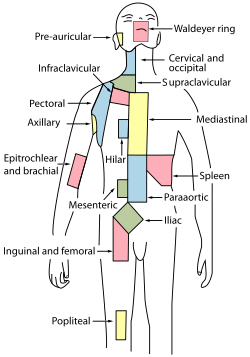Posterior cervical
| Cervical lymph nodes | |
|---|---|

Regional lymph tissue. (Cervical near top, in green.)⋅
|
|

Deep Lymph Nodes
1. Submental 2. Submandibular (Submaxillary) Anterior Cervical Lymph Nodes (Deep) 3. Prelaryngeal 4. Thyroid 5. Pretracheal 6. Paratracheal Deep Cervical Lymph Nodes 7. Lateral jugular 8. Anterior jugular 9. Jugulodigastric Inferior Deep Cervical Lymph Nodes 10. Juguloomohyoid 11. Supraclavicular (scalene) |
|
| Details | |
| Latin | Nodi lymphoidei cervicales |
|
Anatomical terminology
[]
|
|
Cervical lymph nodes are lymph nodes found in the neck. Of the 800 lymph nodes in the human body, 300 are in the neck. Cervical lymph nodes are subject to a number of different pathological conditions including tumours, infection and inflammation.
There are approximately 300 lymph nodes in the neck, and they can be classified in many different ways.
Commonly used systems have been devised by the American Academy of Otolaryngology and the American Joint Committee on Cancer.
One system divides the nodes as follows:
Infectious mononucleosis (glandular fever) affects the cervical lymph nodes which become swollen.
The characterization of cancerous lymph nodes on CT scan, MRI or ultrasound is difficult, and usually requires confirmation by other nuclear imaging techniques such as PET scans. Tissue diagnosis by fine needle aspiration (which has a high rate of accuracy), may also be required. Cervical lymph node metastasis is a common feature of papillary thyroid carcinoma
Henri Rouvière produced an influential classification in 1938. However, this system was based upon anatomical landmarks found in dissection, making it imperfectly suited to the needs of clinicians, which led to new terminology for the lymph nodes that could be palpated.
More recently, classification systems have been proposed organized around what can be observed via diagnostic imaging.
Superficial lymph glands and lymphatic vessels of head and neck.
...
Wikipedia
